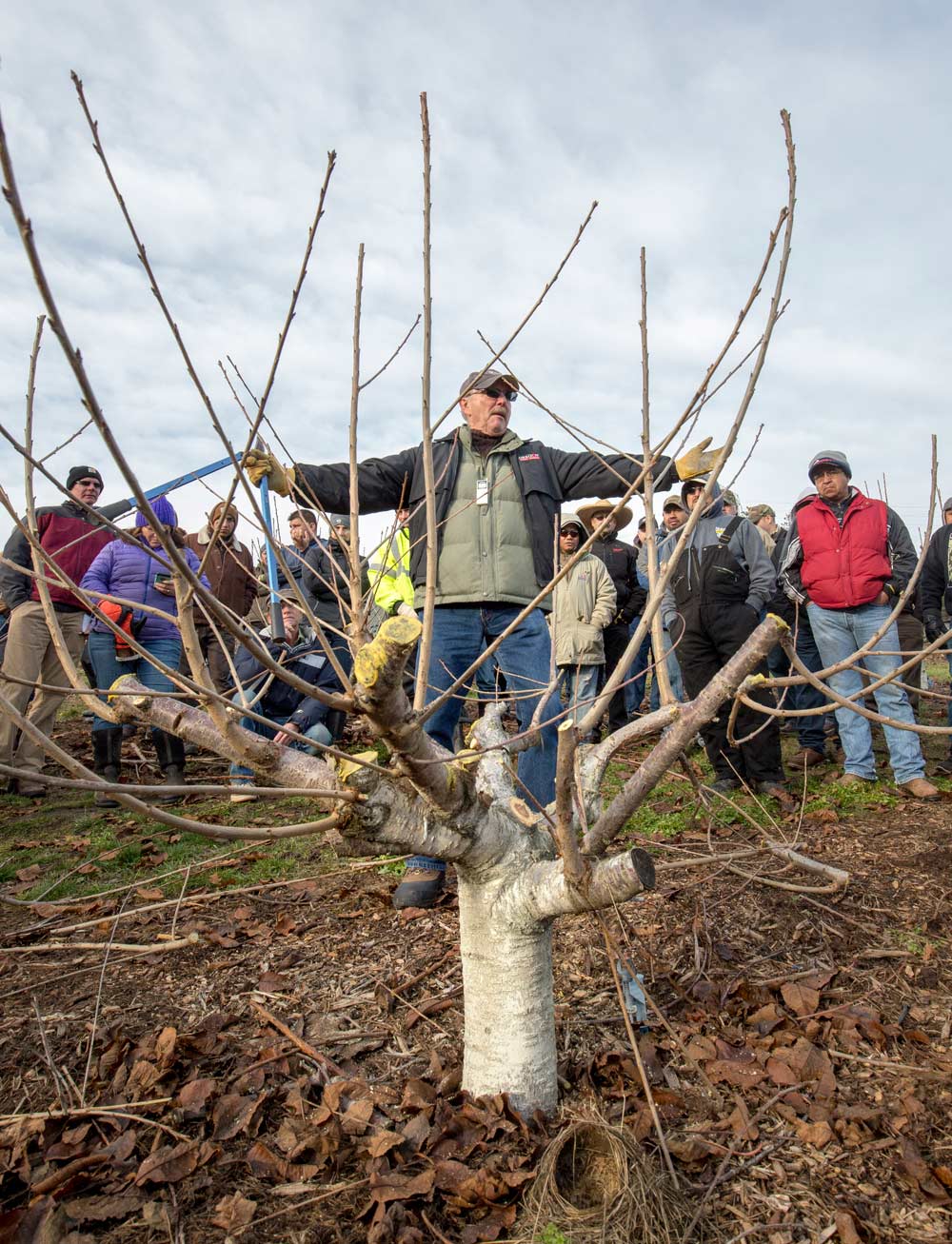
Gipp Redman instructs growers how to winter prune KGB cherry trees in December 2015 in an orchard near The Dalles, Oregon. The KGB tree architecture is popular in the Columbia Gorge and Australia for its low cost to harvest and attractiveness to labor, though growers and experts admit they still have a lot to learn about proper cutting techniques to ensure adequate renewal growth. (TJ Mullinax/Good Fruit Grower file photo)
The KGB cherry tree architecture, fickle to grow yet lauded for the ease of picking it provides, may stand at a crossroads.
Some growers are expanding their acreage of cherries on KGB systems, while others — frustrated with sluggish renewal growth — have been replacing them with other systems in the Columbia Gorge growing region of Oregon.
Lynn Long, Oregon State University extension horticulturist, calls the frustrations a misunderstanding. “It’s true that there have been some issues with renewal growth,” he said. “A large part of that is just a misunderstanding of how to make those cuts.”
The Kym Green Bush, named for the early adopting Australian grower, is characterized by 20 or 30 upright fruit-laden shoots that lend themselves to pedestrian orchards.
Growers typically leave the trees short enough so that pickers can reach all the fruit on the tree by simply bending the canes without using ladders.
Growers also favor KGB for its relative simplicity and lack of trellis or wires.
The system came about partially by accident. Green and Long both visited Europe in 1993 to study the Spanish bush, another pedestrian system.
When they came back, they taught growers to trim away horizontal shoots to force cherries onto the uprights, different than a true Spanish bush in which fruit grows on the laterals.
“KGB was born out of that mistake,” Long said.
The trick is in renewal cuts. The system relies on removing the oldest 15 percent or so of vertical fruiting braches each year, because younger branches produce higher quality fruit. However, cutting a large branch at a fork simply transfers all the growth energy into the remaining fork, rather than into new growth. Both branches of the fork must be cut to encourage even regrowth, Long said.
That’s where growers in The Dalles and Hood River, Oregon, where KGB has become popular, have tripped, Long said.
Still, plenty of growers are sticking with the system as they learn. Some are expanding.
Tim Dahle of The Dalles has about 5 percent of his orchards in KGB and plans to gradually increase to about 15 percent.
“It’s our default system for all replacement trees,” he said, unless those trees are Regina or Kordia trees. Those varieties tend to produce fruit on lateral shoots.
Dahle estimates the KGB trees increase his labor efficiency by 30 to 40 percent and make his orchards safer by eliminating ladders. If not for pedestrian systems, he probably would have turned to H-2A foreign guest visas to recruit enough workers but hasn’t needed to. The 100 or 150 workers he hires each year are enough.
However, he acknowledges the system is not always as simple as advertised, and he is still learning. “It’s touted as something you can teach someone off the street.”
On the other hand, The Dalles orchardist Mike Omeg has been scaling back his KGB blocks because of the renewal growth problems, converting them to a steep leader system. “One-third of time we don’t get response from the upright,” Omeg said.
However, he recognizes the labor benefit.
“Just from that perspective, it is very attractive,” Omeg said. “The harvest staff that we have speaks very highly of KGB.”
In Australia, most growers are now using KGB trees or forms of it, Green said. Working through the renewal cuts are now easy for him, as long as he makes sure to take out enough large limbs.
He also believes the system will work on Regina and Kordia varieties, as long as growers leave a little bit of lateral growth.
He also adopted the architecture due to labor concerns. In Australia, growers pay more than $18 (U.S.) per hour and have trouble finding enough workers. “My system allows us to do all the work with less people and all from the ground,” he said. “We get more productivity from the trees and from labor.” •
– by Ross Courtney






Leave A Comment